2021 Annual Report for: Gelechiidae / Gelechiinae
For species seen in 2021 that had less than or equal to 100 records, full details are included; for more common species, the earliest, latest and highest count by vice-county are shown. The narrative for each species is taken from the main Hantsmoths website, and it is possible that some information on abundance and occurrence can get out of date, as it is impossible to keep up with all changes; however it should give a good introduction to each species. The tables in each species account summarise the previous status, and that for the current year.
For the maps, all records prior to 2021 are shown by a blue dot (the larger the dot, the more recent), with the current year's records shown in red. As previous records are superimposed on any report for 2021, new sites have greater emphasis (i.e. will show as 'more red').
In the species accounts, an asterisk next to a location indicates a new 10km square record; earliest ever dates are highlighted in orange, and latest ever in red. Initials in the species accounts refer to the recorders listed here. Please get in touch if you identify any omissions or errors, in particular if you have records that have yet to be submitted. Details of how to submit records can be found here.
35.085 [B&F: 0762] Athrips mouffetella (Linnaeus, 1758) - Common
Common in woodland and gardens throughout much of England and Wales, rare in Scotland and Ireland. In Hampshire reasonably widespread and common. Recorded on the Isle of Wight for the first time in over 50 years at Newtown Meadows in 2011. Wingspan 15-16 mm. Comes readily to light; fairly distinctive. Larva feeds on Honeysuckle, Fly Honeysuckle and Snowberry, living within a spun or rolled leaf.
Records prior to 2021
| Vice County | #Records | #Individuals | First Record | Last Record |
|---|---|---|---|---|
| 10 | 14 | 11 | 1889 | 2019 |
| 11 | 124 | 125 | 1972 | 2020 |
| 12 | 72 | 81 | 1980 | 2020 |
2021 records
| Vice County | #Records | #Individuals | Max Quantity |
|---|---|---|---|
| 11 | 4 | 5 | 2 |
| 12 | 3 | 5 | 3 |
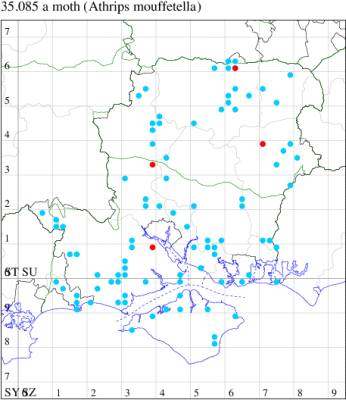
Records by year
Records by week (adult)
Records by week (larval)
Record Details
VC11: Marchwood, one, 14 Jun (CTha); Winter Down Copse, Little Somborne, one, 11 Aug; two, 11 Aug; one, 11 Aug (GCE);
VC12: Pamber Forest, three, 16 Jul (GJD); Alton, one, 20 Jul; one, 25 Jul (DBO)
35.091 [B&F: 0841] Sophronia semicostella (Hübner, [1813]) - Local
Local in grassland and open woodland throughout England and Wales. The distribution in Hampshire mirrors those areas in which trapping effort is concentrated, and the moth is probably more widely distributed than the records suggest; very infrequently recorded from the Isle of Wight. Wingspan 18-19 mm. The combination of remarkable, tufted labial palps and white costal streak is shared by the superficially similar Pleurota bicostella, which see. Larva feeds within lower stems of Sweet Vernal-grass.
Records prior to 2021
| Vice County | #Records | #Individuals | First Record | Last Record |
|---|---|---|---|---|
| 10 | 10 | 10 | 1974 | 2020 |
| 11 | 49 | 56 | 1974 | 2019 |
| 12 | 41 | 78 | 1971 | 2020 |
2021 records
| Vice County | #Records | #Individuals | Max Quantity |
|---|---|---|---|
| 10 | 1 | 1 | 1 |
| 11 | 1 | 1 | 1 |
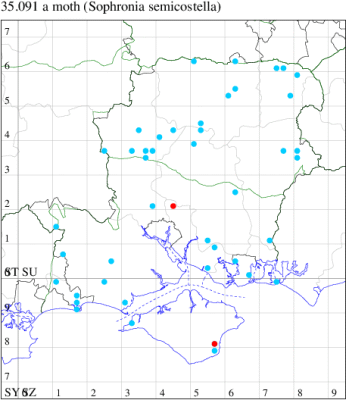
Records by year
Records by week (adult)
Records by week (larval)
Record Details
VC10: Shanklin, one, 18 Jul (IOut);
VC11: Allbrook, one, 08 Jul (SIng)
35.093 [B&F: 0792] Mirificarma mulinella (Zeller, 1839) - Common
Common on heathland and waste ground throughout the British Isles. In Hampshire fairly common in the south, but rather scarce in the north and on the Isle of Wight. Wingspan 11-15 mm. Larva feeds on flower buds of Gorse and Broom.
Records prior to 2021
| Vice County | #Records | #Individuals | First Record | Last Record |
|---|---|---|---|---|
| 10 | 21 | 20 | 1856 | 2020 |
| 11 | 145 | 188 | 1971 | 2020 |
| 12 | 18 | 32 | 1977 | 2020 |
2021 records
| Vice County | #Records | #Individuals | Max Quantity |
|---|---|---|---|
| 10 | 1 | 1 | 1 |
| 11 | 2 | 2 | 1 |
| 12 | 2 | 2 | 1 |
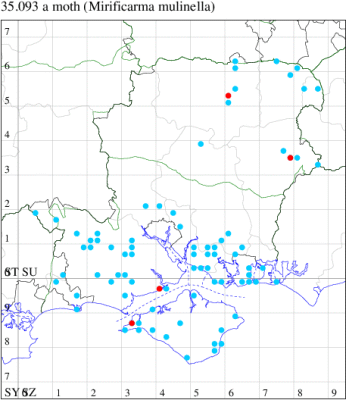
Records by year
Records by week (adult)
Records by week (larval)
Record Details
VC10: Freshwater, one, 20 Aug (DCoo);
VC11: Needs Ore NNR, one, 19 Aug (PCra); one, 18 Aug (CNB);
VC12: Basingstoke, one, 19 Jul (MJW); Whitehill, one, 28 Aug (ASto)
35.094 [B&F: 0796] Aroga velocella (Zeller, 1839) - Local
Local on heathland, moorland and in woodland clearings throughout much of England. Very local and uncommon in Hampshire and on the Isle of Wight, where most frequent on the coast, and around the eastern heaths, but apparently absent from much of the New Forest. Wingspan 14-19 mm. Flies in afternoon sunshine and at night. A relatively distinctive and well-marked gelechiid, but confirmation of worn or poorly marked specimens only possible by dissection of the genitalia. Larva feeds on Sheep's Sorrel, living within a silken tube or tent.
Records prior to 2021
| Vice County | #Records | #Individuals | First Record | Last Record |
|---|---|---|---|---|
| 10 | 6 | 8 | 1959 | 2017 |
| 11 | 79 | 108 | 1975 | 2020 |
| 12 | 40 | 75 | 1989 | 2020 |
2021 records
| Vice County | #Records | #Individuals | Max Quantity |
|---|---|---|---|
| 10 | 1 | 1 | 1 |
| 11 | 5 | 61 | 28 |
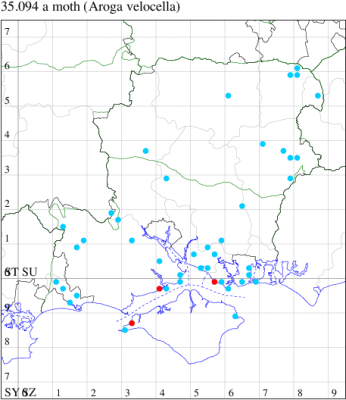
Records by year
Records by week (adult)
Records by week (larval)
Record Details
VC10: Totland, one, 27 Jul (RTer);
VC11: Needs Ore NNR, four, 19 Aug (PCra); 28, 18 Aug (CNB); 24, 19 Aug (PCra); Browndown Coastal Ranges, four, gen det, 20 Aug (RJD, MLO, DWal, KJW det. RJD); one, 27 Aug (MLO, ADT, DWal, KJW)
35.099 [B&F: 0801a] Gelechia senticetella (Staudinger, 1859) - Nationally Scarce B
Nationally scarce (Nb) in parks and gardens in parts of south-eastern England. An adventive species, naturalised through accidental introduction on coniferous plants from southern Europe and now fully established. In Hampshire most records are from the Portsmouth area. Not recorded from the Isle of Wight to date. Wingspan 10-13 mm. Can be distinguished from other superficially similar brown gelechiids using external characteristics only with great care. Larva mines leaves of Juniper and Lawson's Cypress, subsequently living within a silken tube or tent.
Records prior to 2021
| Vice County | #Records | #Individuals | First Record | Last Record |
|---|---|---|---|---|
| 11 | 172 | 221 | 1993 | 2020 |
| 12 | 7 | 7 | 2001 | 2020 |
2021 records
| Vice County | #Records | #Individuals | Max Quantity |
|---|---|---|---|
| 11 | 4 | 5 | 2 |
| 12 | 4 | 4 | 1 |
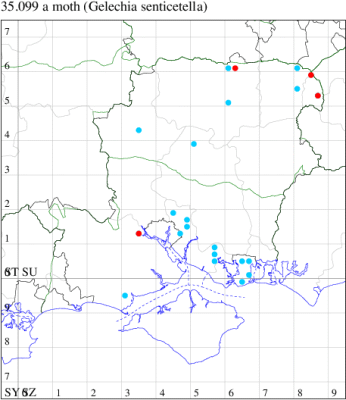
Records by year
Records by week (adult)
Records by week (larval)
Record Details
VC11: Totton, one, 14 Jul; one, 20 Jul; two, 21 Jul; one, 30 Jul (LHan);
VC12: Pamber Forest*, one, 16 Jul (GJD); Blackwater, one, 11 Aug; one, 14 Aug (BDal); Farnborough, one, 22 Jul (KBW)
35.101 [B&F: 0802a] Gelechia sororculella (Hübner, [1817]) - Local
Common, in woodland, scrubland and marshes, throughout Britain. Possibly under-recorded in Hampshire, given the widespread nature of the foodplant. Wingspan 13-15mm. A brown gelechiid which is distinguished from its congeners by the distinctive white ringed discal spot splitting a black streak along the fold, and a pale angulate postmedian fascia. Larva feeds on catkins and leaves of Goat Willow and Grey Willow, living within a spinning.
Records prior to 2021
| Vice County | #Records | #Individuals | First Record | Last Record |
|---|---|---|---|---|
| 10 | 6 | 3 | 1929 | 2012 |
| 11 | 37 | 36 | 1976 | 2017 |
| 12 | 8 | 13 | 1975 | 2020 |
2021 records
| Vice County | #Records | #Individuals | Max Quantity |
|---|---|---|---|
| 12 | 1 | 1 | 1 |
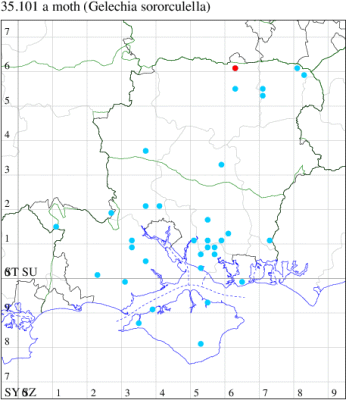
Records by year
Records by week (adult)
Records by week (larval)
Record Details
VC12: Pamber Forest, one, 16 Jul (GJD)
35.107 [B&F: 0859] Psoricoptera gibbosella (Zeller, 1839) - Local
Local in mature oak woodland throughout much of southern England and southern Wales, with records north to Cheshire. In Hampshire recorded from both vice-counties, with notable populations in the New Forest, Harewood Forest, Pamber Forest and Botley Wood; on the Isle of Wight, there have been no recent records. Wingspan 15-17 mm. Larva feeds on Oak, living within a spun or rolled leaf, over-wintering as an egg.
Records prior to 2021
| Vice County | #Records | #Individuals | First Record | Last Record |
|---|---|---|---|---|
| 10 | 4 | 28 | 1900 | 1977 |
| 11 | 53 | 66 | 1967 | 2020 |
| 12 | 33 | 38 | 1974 | 2020 |
2021 records
| Vice County | #Records | #Individuals | Max Quantity |
|---|---|---|---|
| 11 | 10 | 11 | 2 |
| 12 | 3 | 3 | 1 |
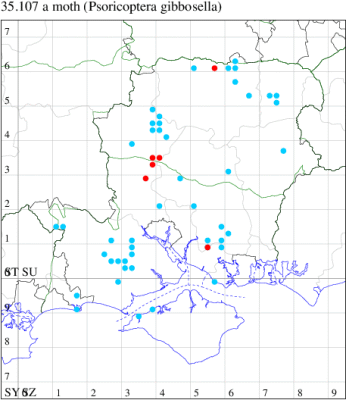
Records by year
Records by week (adult)
Records by week (larval)
Record Details
VC11: Ashley, one, 20 Aug; Winter Down Copse, Little Somborne, two, 01 Sep; one, 11 Aug; one, 01 Sep; one, 11 Aug; one, 11 Aug; one, 11 Aug; one, 01 Sep; one, 11 Aug (GCE); Botley Wood, one, gen det, 13 Aug (MLO, ADT, DWal, KJW det. RJD);
VC12: Little Somborne, one, 13 Aug; Crawley, one, 13 Aug (GCE); Great Haughurst Copse, Axmansford, one, 20 Aug (ACB det. MJW)
35.109 [B&F: 0822] Scrobipalpa acuminatella (Sircom, 1850) - Common
Common on rough meadows, parkland, field-edges and chalk downland throughout much of the British Isles. In Hampshire generally widespread and fairly common. On the Isle of Wight, there is just one record, on Tennyson Down in 1987. Wingspan 10-14 mm. Can be confused with S. pauperella but both are reliably distinguished by their genitalia. Larva mines leaves of Thistle, both Carduus and Cirsium, and Colt's-foot.
Records prior to 2021
| Vice County | #Records | #Individuals | First Record | Last Record |
|---|---|---|---|---|
| 10 | 8 | 5 | 1928 | 2018 |
| 11 | 279 | 291 | 1972 | 2020 |
| 12 | 61 | 70 | 1967 | 2019 |
2021 records
| Vice County | #Records | #Individuals | Max Quantity |
|---|---|---|---|
| 10 | 1 | 1 | 1 |
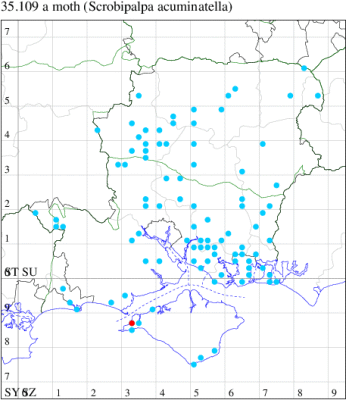
Records by year
Records by week (adult)
Records by week (larval)
Record Details
VC10: Totland, one, 28 May (RTer)
35.114 [B&F: 0812] Scrobipalpa instabilella (Douglas, 1846) - Nationally Scarce B
Nationally scarce (Nb) on saltmarshes, mud-flats and estuaries along parts of the coast of England and Wales, uncommonly in Scotland and Ireland. In Hampshire widely distributed along the coast from Hurst Castle in the west to the eastern side of Hayling Island. Not recorded from the Isle of Wight since 1926. Wingspan 12-14 mm. S. instabilella can be confused with S. salinella, although they can be distinguished by small but constant differences in their genitalia; some examples of S. samadensis can also be similar, but S. instabilella generally has more heavily marked stigmata (MBGBI Vol 4 part 2). Larva mines leaves of Sea-purslane, Grass-leaved Orache, Sea Aster and Glasswort.
Records prior to 2021
| Vice County | #Records | #Individuals | First Record | Last Record |
|---|---|---|---|---|
| 10 | 5 | 2 | 1850 | 2018 |
| 11 | 40 | 50 | 1974 | 2020 |
2021 records
| Vice County | #Records | #Individuals | Max Quantity |
|---|---|---|---|
| 11 | 1 | 1 | 1 |
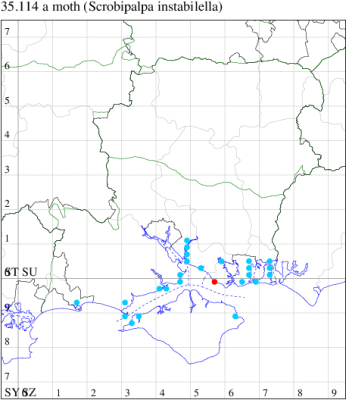
Records by year
Records by week (adult)
Records by week (larval)
Record Details
VC11: Browndown Coastal Ranges, one, gen det, 20 Aug (RJD, MLO, DWal, KJW det. RJD)
35.118 [B&F: 0814] Beet Moth Scrobipalpa ocellatella (Boyd, 1858) - Nationally Scarce B
Scarce on vegetated shingle and in salt-marshes along parts of the coast of southern England. In Hampshire historically a local but not infrequently recorded species of the Hampshire coast, from Hurst Castle in the west, to Hayling Island in the east, but went unrecorded from the Isle of Wight since the mid 1970s. However 2022 saw an unprecedented influx, presumably from the continent, across the south and east of the country, which resulted in 85 reports (compared to 100 previous in total) across the whole of our area between 12th August and the last on 23rd September, which brought multiple new 10km square records and included the first records for North Hampshire.
Wingspan 11-15 mm. Most likely to be confused with S. atriplicella, but more contrastingly marked with angulate fascia at about three-quarters (MBGBI Vol 4 part 2), while S. instabilella generally appears darker and S. nitentella greyer than S. ocellatella. Larva mines leaves of Sea Beet.
Records prior to 2021
| Vice County | #Records | #Individuals | First Record | Last Record |
|---|---|---|---|---|
| 10 | 7 | 7 | 1923 | 2020 |
| 11 | 87 | 68 | 1975 | 2020 |
2021 records
| Vice County | #Records | #Individuals | Max Quantity |
|---|---|---|---|
| 11 | 1 | 1 | 1 |
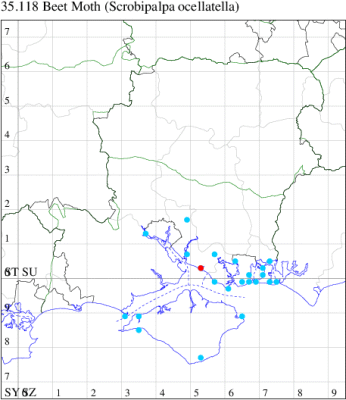
Records by year
Records by week (adult)
Records by week (larval)
Record Details
VC11: Hill Head, one, field observation, 03 Jul (DDex det. BSal)
35.119 [B&F: 0811] Scrobipalpa samadensis (Pfaffenzeller, 1870) - Nationally Scarce B
Nationally scarce (Nb) on salt-marshes and vegetated shingle along parts of the coast of the British Isles. In Hampshire recorded for the first time at Titchfield Haven on 1 July 1978, with another at Southsea on 6 August 1984, but not reported again in our area until one at Chale, Isle of Wight in July 2021. Since found on three occasions at Hengistbury Head, VC11, and it is almost certainly resident here and along the adjacent coast in suitable habitat. Wingspan 11-15 mm; S. atriplicella, S. instabilella and S. nitentella are all similar, and the species can only be distinguished from S. stangei, formerly known only from the Isle of Wight, by dissection of the genitalia. Larva mines leaves of Sea Plantain and Buckshorn Plantain.
Records prior to 2021
| Vice County | #Records | #Individuals | First Record | Last Record |
|---|---|---|---|---|
| 10 | 5 | 1 | 1900 | 1982 |
| 11 | 2 | 2 | 1978 | 1984 |
2021 records
| Vice County | #Records | #Individuals | Max Quantity |
|---|---|---|---|
| 10 | 1 | 1 | 1 |
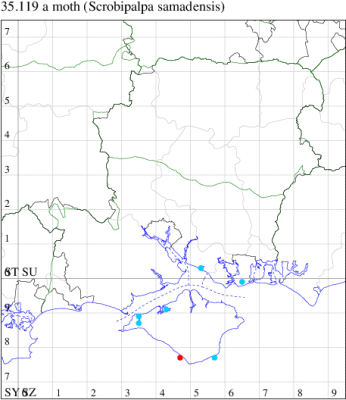
Records by year
Records by week (adult)
Records by week (larval)
Record Details
VC10: Chale, one, field observation, disturbed from a patch of Thymus polytrichus: gen det, 12 Jul (PBar)
35.123 [B&F: 0819] Scrobipalpa costella (Humphreys & Westwood, 1845) - Common
Common in a wide range of habitats, from hedgerows, damp woodland and gardens to shingle beaches, throughout Britain, but less numerous in the north. Widespread and common in Hampshire and on the Isle of Wight. Wingspan 12-14 mm. Quite variable in appearance, but the general pattern is discernible on even the darkest individuals. Larva mines leaves of Woody Nightshade.
Records prior to 2021
| Vice County | #Records | #Individuals | First Record | Last Record |
|---|---|---|---|---|
| 10 | 201 | 257 | 1893 | 2020 |
| 11 | 1081 | 1268 | 1953 | 2020 |
| 12 | 165 | 173 | 1990 | 2020 |
2021 records
| Vice County | #Records | #Individuals | Max Quantity |
|---|---|---|---|
| 10 | 19 | 20 | 2 |
| 11 | 16 | 17 | 2 |
| 12 | 3 | 3 | 1 |
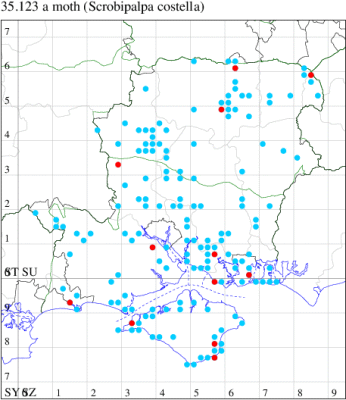
Records by year
Records by week (adult)
Records by week (larval)
Record Details
VC10: Totland, one, 30 Aug; one, 23 Oct (RTer); Freshwater, one, field observation, 28 Jun; one, 17 Aug; one, 09 Sep; one, 08 Oct; one, 12 Oct; one, 13 Oct; two, 25 Oct; one, 20 Nov; one, 14 Dec; one, 15 Dec; one, 18 Dec (DCoo); Bonchurch, one, 12 May; one, 17 May; one, 22 May; one, 31 May; one, 16 Oct (JHa); Shanklin, one, 09 Nov (IOut);
VC11: Broughton Down, one, 12 Jun (MBot); Marchwood, one, 06 Sep (CTha); Fareham, one, 18 Mar (MLO); Portsmouth, one, 01 Jul; one, 03 Jul; one, 10 Aug; one, 14 Aug; one, 26 Sep; one, 24 Oct; one, 26 Oct; one, 10 Nov; one, 11 Dec; two, 14 Dec; one, 31 Dec (IRT); Tuckton, Christchurch, one, 09 Nov (APar); Browndown Coastal Ranges, one, gen det, 08 Oct (MLO, ADT, DWal, KJW);
VC12: Kempshott, one, 03 Aug (GAH); Pamber Forest, one, 24 Jun (GJD); Blackwater, one, 03 Jun (BDal)
35.127 [B&F: 0825a] Tuta absoluta (Meyrick, 1917) - Adventive
Recorded infrequently through accidental importation in tomatoes from southern Europe. Originally a resident of South America, but from 2006 increasingly common in Spain in greenhouses that grow tomatoes. In March 2009 found in Britain in imported Spanish tomatoes, with records from a number of packing sites and greenhouses subsequently. Recorded for the first time in Hampshire in 2014, and Wight in 2018, with sporadic records subsequently: the number of records from the island probably do not reflect the true nature of its status, as anecdotedly it is known that specimens have been recorded at commercial tomato growers on the Island since 2009. Wingspan 8-10 mm. Larva feeds on Tomato, causing sufficient damage to be a serious pest in some areas.
Records prior to 2021
| Vice County | #Records | #Individuals | First Record | Last Record |
|---|---|---|---|---|
| 10 | 3 | 3 | 2018 | 2020 |
| 11 | 3 | 3 | 2014 | 2019 |
2021 records
| Vice County | #Records | #Individuals | Max Quantity |
|---|---|---|---|
| 10 | 1 | 1 | 1 |
| 11 | 1 | 1 | 1 |
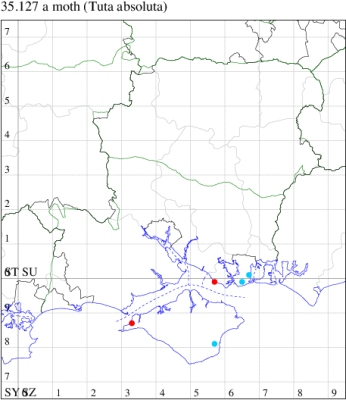
Records by year
Records by week (adult)
Records by week (larval)
Record Details
VC10: Totland, one, 22 Oct (RTer);
VC11: Browndown Coastal Ranges, one, gen det, 08 Oct (MLO, ADT, DWal, KJW)
35.133 [B&F: 0832] Caryocolum blandella (Douglas, 1852) - Nationally Scarce B
Nationally scarce (Nb) in hedgerows and woodland throughout much of England, Wales and southern Ireland. In Hampshire has been recorded in the past from the Avon Valley, in the vicinity of Portsmouth Harbour, and around Selborne. On the Isle of Wight, the first recent records for some years were received from Freshwater in 1997 and 2000. Wingspan 9.5-14.5 mm. C. blandulella is generally smaller and whiter and lacks a distinct row of terminal spots; C. blandelloides, C. kroesmanniella and C. huebneri lack the very dark bar from costa to fold which completely obscures the costal and plical spots (MBGBI Vol 4 part 2). Larva feeds on shoots of Greater Stitchwort, subsequently feeding on the seed heads.
Records prior to 2021
| Vice County | #Records | #Individuals | First Record | Last Record |
|---|---|---|---|---|
| 10 | 7 | 2 | 1893 | 2012 |
| 11 | 5 | 2 | 1990 | 2006 |
| 12 | 5 | 6 | 1996 | 2018 |
2021 records
| Vice County | #Records | #Individuals | Max Quantity |
|---|---|---|---|
| 12 | 1 | 1 | 1 |
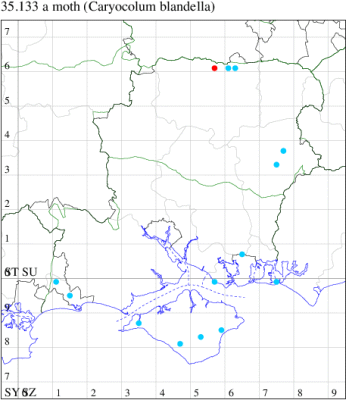
Records by year
Records by week (adult)
Records by week (larval)
Record Details
VC12: Great Haughurst Copse, Axmansford, one, 20 Aug (ACB det. MJW)
35.141 [B&F: 0765] Teleiodes vulgella ([Denis & Schiffermüller], 1775) - Common
Common in gardens, scrub, open woodland and hedgerows throughout England and Wales, but rare in Ireland. Widespread and common in Hampshire, but rather scarce on the Isle of Wight. Wingspan 11-13 mm. Larva feeds on Hawthorn and Blackthorn, living between leaves spun together with silk.
Records prior to 2021
| Vice County | #Records | #Individuals | First Record | Last Record |
|---|---|---|---|---|
| 10 | 65 | 76 | 1900 | 2020 |
| 11 | 650 | 813 | 1972 | 2020 |
| 12 | 86 | 95 | 1980 | 2020 |
2021 records
| Vice County | #Records | #Individuals | Max Quantity |
|---|---|---|---|
| 10 | 10 | 15 | 4 |
| 11 | 30 | 31 | 2 |
| 12 | 6 | 6 | 1 |
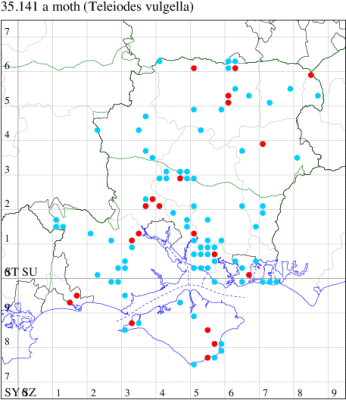
Records by year
Records by week (adult)
Records by week (larval)
Record Details
VC10: Totland, one, 21 Jul; two, 23 Jul; one, 30 Aug (RTer); Freshwater, one, 16 Jul; one, 18 Jul (DCoo); Rew Down, Ventnor, one, 13 Jul (PBar); Haseley Manor, one, 19 Jul; Shanklin, two, 17 Jul; four, 20 Jul; one, 04 Aug (IOut);
VC11: Woodlands, NF, present, 07 Jul (RBW); Totton, one, 13 Jul; one, 16 Jul (LHan); Romsey, two, 07 Jul (MBak); one, 02 Jun (NRJ); Valley Park, Chandlers Ford, one, 14 Jul; one, 17 Jul; two, 22 Jul; one, 30 Jul (KArb); Winchester, one, 30 Jun; one, 08 Jul (THW); Fareham, one, 15 Jul; one, 18 Jul; one, 19 Jul; one, 25 Jul; one, 03 Aug; one, 11 Aug; one, 12 Aug (MLO); Botley, one, 03 Jul; one, 11 Jul (SLB); Portsmouth, one, 04 Jul; one, 07 Jul; one, 13 Jul; one, 14 Jul; one, 18 Jul (IRT); Tuckton, Christchurch, one, 13 Jul; one, 17 Jul; one, 24 Jul (APar); Burton, nr Christchurch, one, 16 Jul; one, 04 Aug (JStw);
VC12: Ecchinswell, one, 01 Jul (MJN); Basingstoke, one, 19 Jul (MJW); one, 12 Jun (RHil); Pamber Forest, one, 16 Jul (GJD); Alton, one, 30 Jun (DBO); Blackwater, one, 27 Jul (BDal)
35.142 [B&F: 0769] Teleiodes wagae (Nowicki, 1860) - Nationally Scarce A
Nationally scarce (Na) in hedgerows and scrubland in Hampshire, Sussex, Surrey and Kent, but first recorded in the UK from the Burren, Co. Clare in 1961, where still reasonably common. First recorded in Hampshire at Botley Wood in 1976, this also being the first record in Britain, also known from Sparsholt. Not recorded from the Isle of Wight to date. Wingspan 12-14 mm. The most likely confusion species are Carpatolechia notatella, but T. wagae has a lighter ground colour and the markings are distinct black dots, whereas in C. notatella they are streak-like and diffuse; and Pseudotelphusa paripunctella, which has only two black dots at two-fifths, whereas T. wagae has four black dots in that area. Larva feeds on Hazel, Birch and Sweet Chestnut, living within a spun or rolled leaf, over-wintering as a pupa.
Records prior to 2021
| Vice County | #Records | #Individuals | First Record | Last Record |
|---|---|---|---|---|
| 11 | 8 | 6 | 1980 | 2018 |
2021 records
| Vice County | #Records | #Individuals | Max Quantity |
|---|---|---|---|
| 11 | 1 | 1 | 1 |
| 12 | 1 | 1 | 1 |
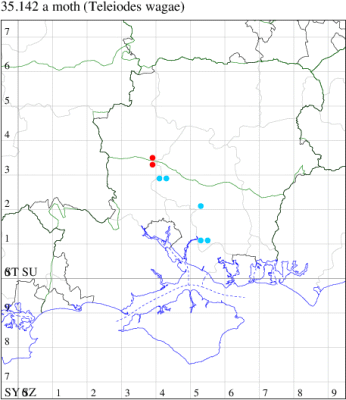
Records by year
Records by week (adult)
Records by week (larval)
Record Details
VC11: Winter Down Copse, Little Somborne, one, 02 Jun (GCE);
VC12: New Vice-county Record: Crawley, one, 05 Jun (GCE)
35.143 [B&F: 0774] Teleiodes luculella (Hübner, [1813]) - Common
Common in oak woodland throughout England and Wales. Widespread and common in Hampshire. Not recorded from the Isle of Wight since 1856. Wingspan 10-12 mm. Superficially similar to the very rare immigrant T. flavimaculella, which see. Larva feeds on Oak, living between leaves spun together with silk, over-wintering as a pupa.
Records prior to 2021
| Vice County | #Records | #Individuals | First Record | Last Record |
|---|---|---|---|---|
| 10 | 22 | 25 | 1856 | 2020 |
| 11 | 296 | 386 | 1958 | 2020 |
| 12 | 190 | 438 | 1976 | 2020 |
2021 records
| Vice County | #Records | #Individuals | Max Quantity |
|---|---|---|---|
| 10 | 3 | 3 | 1 |
| 11 | 28 | 31 | 3 |
| 12 | 14 | 21 | 6 |
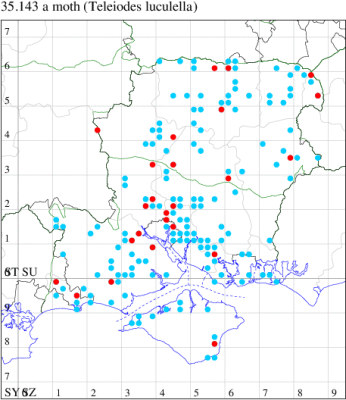
Records by year
Records by week (adult)
Records by week (larval)
Record Details
VC10: Shanklin, one, 02 Jul; one, 17 Jul; one, 18 Jul (IOut);
VC11: Marchwood, two, 02 Jun; one, 20 Jun; one, 19 Jul; one, 01 Aug (CTha); Woodlands, NF, present, 02 Jul (RBW); Totton, one, 10 Jun; one, 13 Jul (LHan); Romsey, one, 10 Jun; two, 12 Jun (MBak); one, 02 Jun; one, 09 Jun; one, 11 Jun (NRJ); Winter Down Copse, Little Somborne, one, 02 Jun; one, 02 Jun; one, 02 Jun; two, 02 Jun; three, 02 Jun (GCE); Chandlers Ford, one, 03 Jun (AMur); Swaythling, Southampton, one, 24 Jul (MEdg); Southampton, one, 18 Jul (MGP); Allbrook, one, 15 Jul; one, 20 Jul; two, 21 Jul (SIng); Fareham, one, 02 Jun (MLO); Merritown Heath, present, 10 Jun (DFoo); Burton, nr Christchurch, one, 20 Jul; one, 04 Aug (JStw); Sway, present, 18 Jul (DMui);
VC12: Cholderton, one, 02 Jul (TJN, LFom, HEdm); Crawley, one, 14 Jun; Bullington, one, 16 Jul (GCE); Basingstoke, two, 12 Jun; one, 14 Jun; two, 16 Jun (GAH); Great Haughurst Copse, Axmansford, one, 10 Jun (ACB det. ); Cheriton Wood, one, field observation, 23 Jun (DAS); Pamber Forest, six, 09 Jun (GJD); Whitehill, one, 02 Jun; one, 11 Jun (ASto); Blackwater, one, 11 Jun; one, 21 Jul (BDal); Farnborough, one, 02 Jun (KBW)
35.146 [B&F: 0776] Teleiopsis diffinis (Haworth, 1828) - Common
Common on grassland and heaths throughout much of Britain, but not recorded from the Outer Hebrides or Shetland; local or under-recorded in Ireland (MBGBI Vol 4 part 2). In Hampshire probably under-recorded, the extent of known records correlating with those areas in which the recording effort is concentrated. Recorded on the Isle of Wight in 1973 and 2009. Wingspan 14-16 mm. Larva feeds within roots of Sheep's Sorrel, living within a silken tube or tent.
Records prior to 2021
| Vice County | #Records | #Individuals | First Record | Last Record |
|---|---|---|---|---|
| 10 | 8 | 6 | 1973 | 2020 |
| 11 | 110 | 223 | 1971 | 2020 |
| 12 | 50 | 125 | 1996 | 2020 |
2021 records
| Vice County | #Records | #Individuals | Max Quantity |
|---|---|---|---|
| 10 | 2 | 2 | 1 |
| 11 | 12 | 12 | 3 |
| 12 | 22 | 54 | 7 |
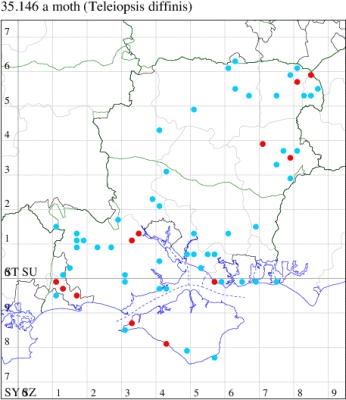
Records by year
Records by week (adult)
Records by week (larval)
Record Details
VC10: Totland, one, 30 May (RTer);
VC11: Woodlands, NF, present, 09 Jun (RBW); Totton, one, 13 Jun; one, 27 Sep; one, 08 Oct; one, 24 Oct (LHan); Merritown Heath, present, 10 Jun (DFoo); Hurn, one, 01 Jun; one, 05 Jun; one, 09 Jun (MJef); Burton, nr Christchurch, one, 23 Jun (JStw); Browndown Coastal Ranges, three, seen by RJDickson, 27 Aug; one, 08 Oct (MLO, ADT, DWal, KJW);
VC12: Alton, present, 19 Aug (BCA); Whitehill, one, 12 May (ASto); Minley Wood, four, field observation, 08 Jun; five, field observation, 09 Jun; one, field observation, 10 Jun; seven, field observation, 13 Jun; two, field observation, 14 Jun; two, field observation, 17 Jun; five, field observation, 20 Jun; one, field observation, 22 Jun; seven, field observation, 23 Jun; four, field observation, 24 Jun; one, field observation, 06 Jul; Yateley Common, one, field observation, 13 Sep; Blackwater, two, 09 Jun; two, 11 Jun; one, 29 Jun; two, 14 Aug; two, 20 Aug; two, 22 Aug; one, 25 Aug; one, 12 Sep (BDal)
35.147 [B&F: 0767] Carpatolechia decorella (Haworth, 1812) - Nationally Scarce B
Nationally scarce (Nb) in woodland and scrub throughout the British Isles. In Hampshire a relatively recent addition to the county fauna, with a handful records in most years, widely distributed across the county. An individual in Osborne Wood in 2022 was the first for the Isle of Wight for many decades. Wingspan 13-14 mm. Separated from C. proximella and C. alburnella by the diagnostic black, longitudinal bar on costa at base of forewing, which is visible in all but the darkest specimens (MBGBI Vol 4 part 2). Larva feeds on Oak and Dogwood, living between leaves spun together with silk.
Records prior to 2021
| Vice County | #Records | #Individuals | First Record | Last Record |
|---|---|---|---|---|
| 10 | 1 | 0 | 1900 | 1900 |
| 11 | 17 | 16 | 1976 | 2017 |
| 12 | 12 | 35 | 1995 | 2015 |
2021 records
| Vice County | #Records | #Individuals | Max Quantity |
|---|---|---|---|
| 11 | 1 | 1 | 1 |
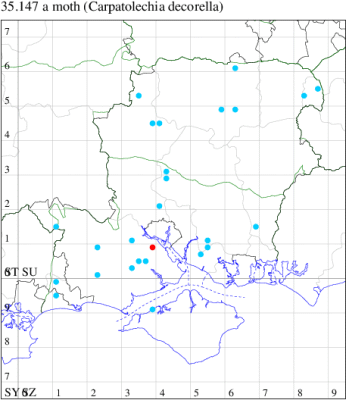
Records by year
Records by week (adult)
Records by week (larval)
Record Details
VC11: Marchwood, one, 18 Nov (CTha)
35.151 [B&F: 0770] Carpatolechia proximella (Hübner, 1796) - Common
Common in open woodland and scrub throughout the British Isles. In Hampshire recorded annually in small numbers from widely scattered locations across the county. Not recorded from the Isle of Wight since 1977. Wingspan 13-16 mm. The main confusion species is C. alburnella, which is generally a much lighter species, except in Scotland where dark forms predominate, and from which reliably distinguished by outer side of second segment of labial palpus, which is spotted fuscous at base in C. proximella (MBGBI Vol 4 part 2); see also C. decorella. Larva feeds on Birch and Alder, living within a spun or rolled leaf, and over-wintering as a pupa.
Records prior to 2021
| Vice County | #Records | #Individuals | First Record | Last Record |
|---|---|---|---|---|
| 10 | 3 | 2 | 1977 | 2019 |
| 11 | 93 | 116 | 1974 | 2020 |
| 12 | 55 | 63 | 1976 | 2020 |
2021 records
| Vice County | #Records | #Individuals | Max Quantity |
|---|---|---|---|
| 11 | 4 | 3 | 1 |
| 12 | 2 | 2 | 1 |
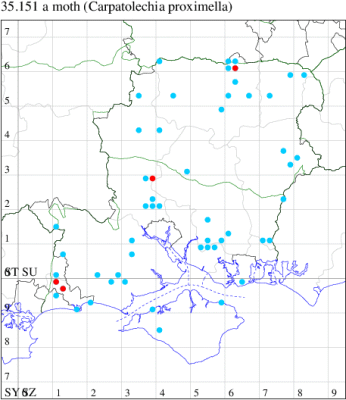
Records by year
Records by week (adult)
Records by week (larval)
Record Details
VC11: Kings Somborne, one, 09 Jun (GCE); Merritown Heath, present, 10 Jun (DFoo); Hurn, one, 07 Jun; one, 30 Jun (MJef);
VC12: Pamber Forest, one, 02 Jun; one, 11 Jun (GJD)
35.156 [B&F: 0757] Recurvaria nanella ([Denis & Schiffermüller], 1775) - Nationally Scarce B
Nationally scarce (Nb) in orchards, gardens, woodland and hedgerows, mainly in southern England, occasionally north to Yorkshire, and in northern Wales. In Hampshire there are scattered record in both vice-counties. Not recorded from the Isle of Wight to date. Wingspan 11-13 mm. Although superficially similar to several other gelechiids, the heavily-bordered, dark basal area and discal markings make the species easy to recognise. Larva mines the leaves in autumn and, after hibernation, the buds and flowers of Apple, Pear and Blackthorn.
Records prior to 2021
| Vice County | #Records | #Individuals | First Record | Last Record |
|---|---|---|---|---|
| 11 | 121 | 137 | 1975 | 2020 |
| 12 | 7 | 10 | 1993 | 2020 |
2021 records
| Vice County | #Records | #Individuals | Max Quantity |
|---|---|---|---|
| 11 | 3 | 3 | 1 |
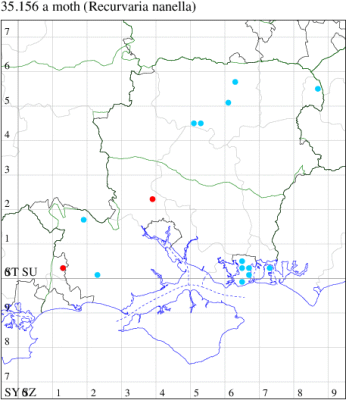
Records by year
Records by week (adult)
Records by week (larval)
Record Details
VC11: Ashley Heath*, one, 10 Sep (SDut); Romsey, one, 17 Jul; one, 09 Aug (NRJ)
35.157 [B&F: 0758] Recurvaria leucatella (Clerck, 1759) - Local
Local in hedgerows and orchards throughout much of England and northern Wales. In Hampshire the main population centres are in the New Forest and between the Hamble and Wallington rivers; there are few records elsewhere in the county or on the Isle of Wight. Wingspan 14-15 mm. Larva feeds on Hawthorn, Apple and Rowan, living within a spun or rolled leaf.
Records prior to 2021
| Vice County | #Records | #Individuals | First Record | Last Record |
|---|---|---|---|---|
| 10 | 10 | 10 | 2002 | 2013 |
| 11 | 68 | 93 | 1974 | 2020 |
| 12 | 11 | 10 | 1996 | 2020 |
2021 records
| Vice County | #Records | #Individuals | Max Quantity |
|---|---|---|---|
| 11 | 1 | 1 | 1 |
| 12 | 1 | 2 | 2 |
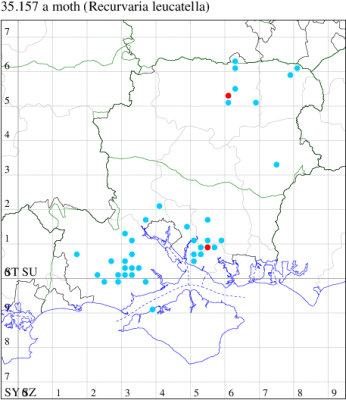
Records by year
Records by week (adult)
Records by week (larval)
Record Details
VC11: Botley Wood, one, 30 Jul (RJD, DWal, KJW);
VC12: Basingstoke, two, 19 Jul (MJW)
35.159 [B&F: 0760] Exoteleia dodecella (Linnaeus, 1758) - Local
Local in pine woodland and plantations throughout much of the British Isles, except for the Northern Isles. Probably under-recorded in Hampshire, where the extent of known records correlate with those areas in which the recording effort is concentrated; there have been no recent records from the New Forest. Not recorded from the Isle of Wight since 1900. Wingspan 12-15 mm. When worn, resembles several other gelechiids, from which only reliably separated by dissection of the genitalia. Larva feeds within needles of Scots Pine, Corsican Pine and Maritime Pine, subsequently living within a silken web, causing sufficient damage to be a serious pest in some areas.
Records prior to 2021
| Vice County | #Records | #Individuals | First Record | Last Record |
|---|---|---|---|---|
| 10 | 1 | 0 | 1900 | 1900 |
| 11 | 60 | 60 | 1983 | 2020 |
| 12 | 23 | 24 | 1971 | 2020 |
2021 records
| Vice County | #Records | #Individuals | Max Quantity |
|---|---|---|---|
| 11 | 1 | 1 | 1 |
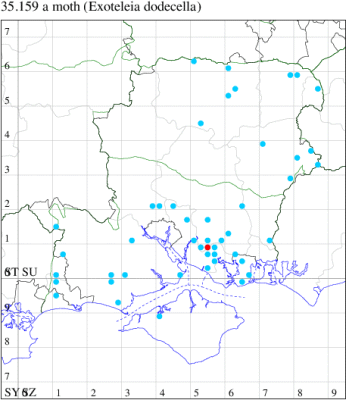
Records by year
Records by week (adult)
Records by week (larval)
Record Details
VC11: Botley Wood, one, 30 Jul (RJD, DWal, KJW det. RJD)
35.160 [B&F: 0755] Stenolechia gemmella (Linnaeus, 1758) - Local
Local in woodland throughout much of England and Wales. In Hampshire recorded infrequently from a number of widely scattered localities, more often than not at light traps in gardens, where occasionally numerous. Not recorded from the Isle of Wight to date. Wingspan 10-11 mm. One of several, superficially similar black and white gelechiids, S. gemmella is characterised by the pattern of large dorsal and smaller costal spot at base, almost complete outwardly oblique fascia at one-half of costa, spot on costa between this and base, and a spot at tornus (MBGBI Vol 4 part 2). Larva feeds within young shoots of Oak.
Records prior to 2021
| Vice County | #Records | #Individuals | First Record | Last Record |
|---|---|---|---|---|
| 10 | 7 | 7 | 2017 | 2020 |
| 11 | 49 | 48 | 1984 | 2020 |
| 12 | 18 | 21 | 1980 | 2020 |
2021 records
| Vice County | #Records | #Individuals | Max Quantity |
|---|---|---|---|
| 10 | 1 | 2 | 2 |
| 11 | 1 | 1 | 1 |
| 12 | 1 | 1 | 1 |
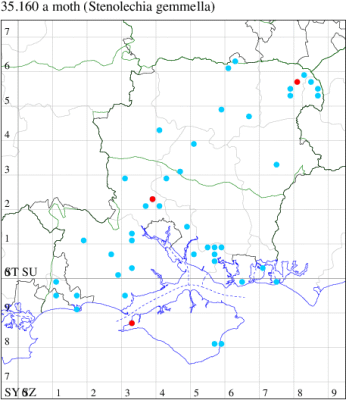
Records by year
Records by week (adult)
Records by week (larval)
Record Details
VC10: Totland, two, 28 Aug (RTer);
VC11: Romsey, one, 23 Aug (NRJ);
VC12: Minley Wood, one, field observation, 03 Aug (BDal)
35.161 [B&F: 0756] Parachronistis albiceps (Zeller, 1839) - Local
Local in Wales and southern England, north to Yorkshire. In Hampshire there are scattered records in both vice-counties. First recorded from the Isle of Wight in 2013. Wingspan 10-11 mm. A distinctive black and white gelechiid with three large subtriangular spots evenly spaced along costa, the basal edge of the first of these often extended into an oblique narrow transverse fascia which joins an elongate streak along dorsum almost to tornus (MBGBI Vol 4 part 2). Larva feeds within young shoots of Hazel.
Records prior to 2021
| Vice County | #Records | #Individuals | First Record | Last Record |
|---|---|---|---|---|
| 10 | 12 | 14 | 2013 | 2020 |
| 11 | 62 | 69 | 1972 | 2020 |
| 12 | 35 | 46 | 1993 | 2020 |
2021 records
| Vice County | #Records | #Individuals | Max Quantity |
|---|---|---|---|
| 10 | 2 | 3 | 2 |
| 11 | 5 | 4 | 1 |
| 12 | 3 | 3 | 1 |
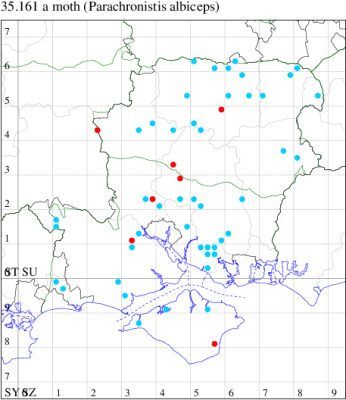
Records by year
Records by week (adult)
Records by week (larval)
Record Details
VC10: Shanklin, two, 29 Jun; one, 02 Jul (IOut);
VC11: Woodlands, NF, present, 02 Jul (RBW); Ashurst, one, 01 Jul (RFC); Romsey, one, 02 Jul; one, 20 Jul (NRJ); Winchester, one, 16 Jul (THW);
VC12: Cholderton, one, 10 Sep (TJN); Crawley, one, 13 Jul (GCE); Basingstoke, one, 28 May (GAH)

()IMG_5937).jpg)
()IMG_5943).jpg)


